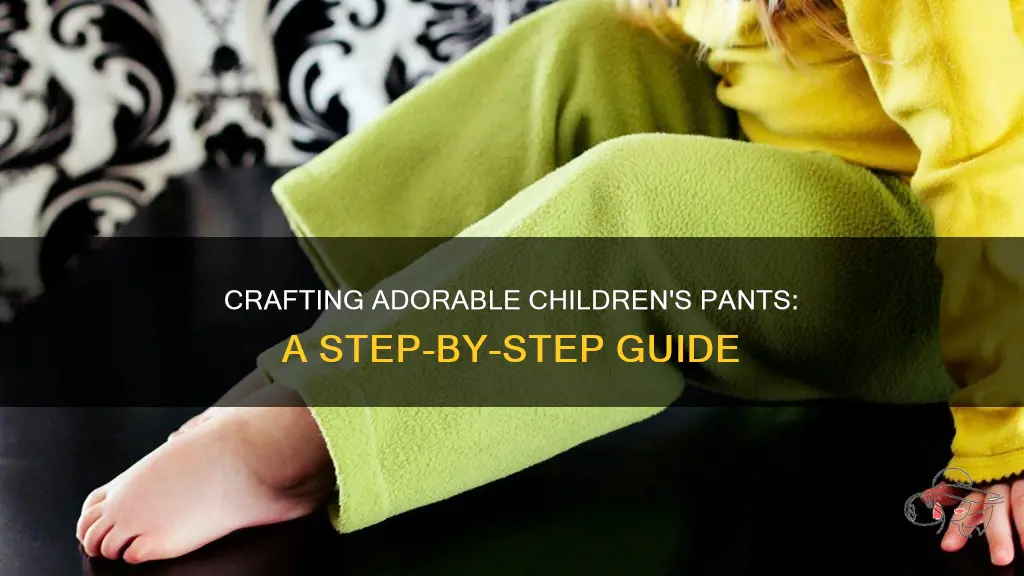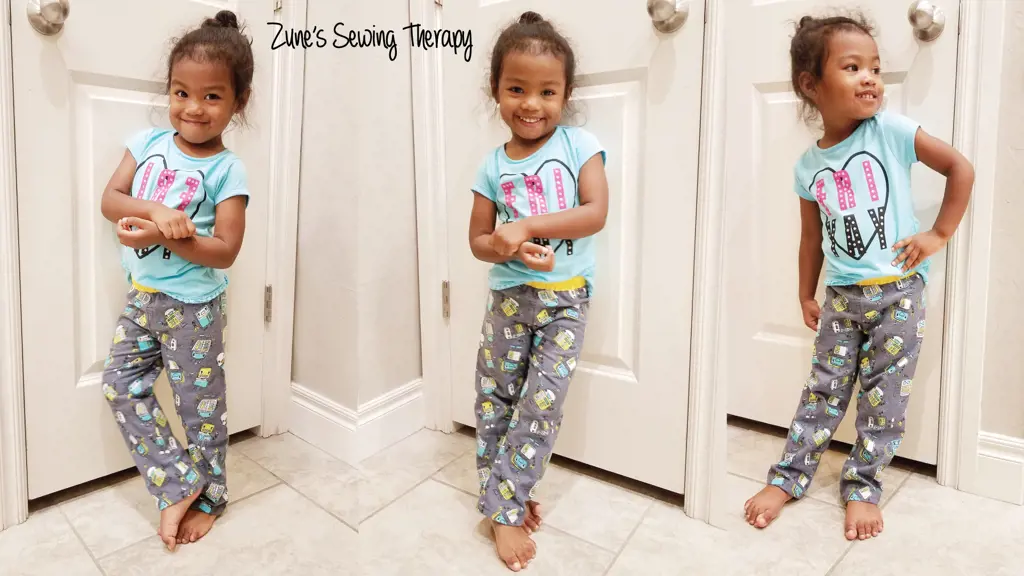
Do you have a little one in need of some new pants? Making your own children's pants can be a creative and rewarding project that allows you to customize the fit, style, and fabric choice. Whether you are a sewing novice or an experienced maker, this guide will walk you through the steps of making children's pants from scratch. From selecting the right pattern to mastering the sewing techniques, get ready to create adorable and unique pants that your child will love to wear!
| Characteristics | Values |
|---|---|
| Size | 2T, 3T, 4T, 5T |
| Material | Cotton, Denim, Polyester |
| Waistband | Elastic, Adjustable |
| Closure | Zipper, Button, Snap |
| Pockets | Front, Back, Side |
| Style | Straight, Skinny, Bootcut |
| Color | Various colors |
| Length | Full-length, Capri, Shorts |
| Embellishments | Embroidery, Patchwork, Appliques |
| Care Instructions | Machine washable, Tumble dry low |
What You'll Learn

Materials Needed for Making Children's Pants

Making children's pants can be a fun and rewarding sewing project. Whether you're a beginner or an experienced sewist, it's important to have the right materials to ensure a successful outcome. Here are the materials you'll need for making children's pants:
- Fabric: Choose a fabric that is suitable for pants, such as cotton, denim, or corduroy. Make sure to select a fabric that is comfortable, durable, and easy to care for. Consider the season and the child's needs when choosing the fabric, for example, a lightweight cotton for summer and a heavier fabric for winter.
- Pattern: Find a pants pattern that is designed for children's sizes. There are many patterns available online or at fabric stores. Look for a pattern that includes multiple size options and clear instructions. You can also use an existing pair of pants as a template for creating your own pattern.
- Scissors: Invest in a good pair of fabric scissors for cutting out the pattern and fabric. It's important to have sharp scissors that can easily cut through the fabric without fraying the edges.
- Pins: Use straight pins to hold the pattern pieces in place while you cut out the fabric. Pins will also be useful when sewing the fabric together, ensuring that the pieces stay aligned.
- Sewing machine: A sewing machine will make the construction process much faster and easier. Make sure your sewing machine is in good working condition, and set it up with the appropriate needle and thread for your fabric.
- Thread: Choose a thread color that matches or complements your fabric. A strong polyester thread is recommended for sewing pants, as it will withstand the wear and tear of regular use.
- Elastic: Elastic is essential for creating a comfortable and adjustable waistband. Look for elastic that is specifically designed for waistbands and is appropriate for the age group you are sewing for.
- Ruler or measuring tape: Accurate measurements are crucial for ensuring a good fit. Use a ruler or measuring tape to take the child's waist, hip, inseam, and outseam measurements before cutting out the fabric. This will ensure that you select the correct pattern size and make any necessary adjustments for a custom fit.
- Optional: Buttons, zippers, or snaps: Depending on the style and design of the pants, you may need additional fasteners such as buttons, zippers, or snaps. Make sure to have the appropriate tools and supplies on hand if you plan to include these details.
- Iron and ironing board: Pressing the fabric and seams as you sew is essential for achieving a professional finish. Make sure to have an iron and ironing board nearby to press the fabric as needed.
Remember, having the right materials is just the first step in making children's pants. Take your time, follow the pattern instructions, and don't be afraid to ask for help if needed. With practice, you'll be able to create beautiful, well-fitting pants that any child will love to wear.
The Ultimate Guide to Finding the Perfect Fit for the Express Photographer Suit Pant
You may want to see also

Step-by-Step Guide to Sewing Children's Pants

Sewing children's pants can be a fun and rewarding project. Whether you are a beginner or an experienced seamstress, following a step-by-step guide can help you create a quality pair of pants that your little ones will love. So, grab your sewing machine and let's get started on making some adorable pants for your children!
Step 1: Gather Your Materials and Measurements
First things first, gather all the materials you will need for the project. This includes fabric, thread, elastic, and any additional embellishments you may want to add. Make sure to choose a fabric that is durable and suitable for children's clothing.
Next, take accurate measurements of your child. Measure their waist, hips, and leg length to determine the correct sizing for the pants. It's important to measure accurately to ensure a well-fitting final product.
Step 2: Draft the Pattern or Use a Commercial Pattern
Once you have your measurements, you have two options for creating the pants pattern. You can either draft your own pattern using your child's measurements, or you can use a commercial pattern. If you choose to draft your own pattern, use a large sheet of paper and follow a pants pattern tutorial to create the pattern pieces for the front and back of the pants, as well as the waistband.
Step 3: Cut Out the Fabric
Now that you have your pattern ready, it's time to cut out the fabric. Lay the fabric flat on your work surface and place the pattern pieces on top. Use pins to secure the pattern pieces in place, and then carefully cut out the fabric pieces using fabric scissors. Be sure to follow the cutting layout provided with your pattern to ensure proper placement and minimal fabric waste.
Step 4: Assemble the Pants
Start by pinning the front and back pieces of the pants together at the inseams. Sew along the pinned edges using a straight stitch. Next, pin and sew the crotch seam in the same manner.
Once the inseam and crotch seams are sewn, it's time to sew the side seams. Pin the front and back pieces of the pants together along the side seams, making sure the right sides of the fabric are facing each other. Sew the side seams using a straight stitch.
Step 5: Create the Waistband
To create the waistband, fold over the top edge of the pants by about 1 inch and press it with an iron. Then fold it over again by about an inch and press it once more. This will create a clean edge for the waistband.
Pin the folded waistband in place and sew along the bottom edge, leaving a small opening to insert the elastic. Measure and cut the elastic to match your child's waist measurement plus an inch of overlap. Attach a safety pin to one end of the elastic and use it to guide the elastic through the waistband casing. Once the elastic is inserted, sew the opening closed.
Step 6: Hem the Bottom of the Pants
Finally, it's time to hem the bottom of the pants. Fold over the raw edges of each pant leg by about 1/2 inch and press with an iron. Then fold the fabric over again by about 1 inch and press it once more. Pin the hem in place and sew along the folded edge using a straight stitch.
Step 7: Finishing Touches
If desired, you can add some finishing touches to the pants, such as decorative topstitching, appliques, or pockets. Get creative and let your personal style shine through!
And there you have it – a step-by-step guide to sewing children's pants. With some basic sewing skills and a little patience, you can create adorable and comfortable pants for your little ones. Happy sewing!
Discover the Pros and Cons of Jogging in Khaki Pants for Your Fitness Routine
You may want to see also

Tips for Adjusting Children's Pants Patterns to Fit Perfectly

When it comes to sewing children's pants, getting the fit just right can sometimes be a challenge. But with a few simple adjustments, you can ensure that the pants fit perfectly and are comfortable for your little ones. Here are some tips for adjusting children's pants patterns to fit perfectly:
- Measure accurately: Start by taking accurate measurements of your child. Measure their waist, hips, and inseam length. Use these measurements to select the appropriate size pattern.
- Lengthen or shorten the pants: If the pants are too long or too short for your child, you can easily adjust the length of the pattern. To lengthen the pants, cut the pattern horizontally at the lengthen/shorten line and add extra fabric as needed. To shorten the pants, cut the pattern at the lengthen/shorten line and overlap the two pieces to remove the excess length.
- Adjust the waist: If the waist of the pants is too tight or too loose, you can make adjustments to ensure a comfortable fit. To make the waist larger, you can add extra fabric to the back waistband or use a larger elastic. To make the waist smaller, you can take in the back waistband or use a smaller elastic.
- Modify the rise: The rise refers to the distance between the waistband and the crotch of the pants. If the rise is too short, it can make the pants uncomfortable for your child. To increase the rise, you can add extra fabric to the top of the pants pattern. If the rise is too long, you can cut away the excess fabric from the pattern.
- Adjust the width: If the pants are too wide or too narrow, you can adjust the width of the pattern. To make the pants wider, you can add extra fabric to the side seams. To make the pants narrower, you can take in the side seams.
- Consider stretch fabrics: Using stretch fabrics can make it easier to achieve a better fit, as they allow for more flexibility and adjustability. Stretch fabrics such as jersey or knit can be more forgiving when it comes to sizing and can provide a comfortable fit for active children.
- Make a muslin or test garment: Before cutting into your final fabric, it's a good idea to make a muslin or test garment using inexpensive fabric. This will allow you to test the fit and make any necessary adjustments before sewing with your desired fabric.
- Sew with seam allowances: When sewing the pants, be sure to sew with seam allowances as specified in the pattern instructions. This will ensure that the pants have enough room for your child to move comfortably.
By following these tips, you can easily adjust children's pants patterns to fit perfectly. Remember to take accurate measurements, make the necessary adjustments, and test the fit before sewing with your final fabric. With a little bit of patience and practice, you'll be able to create comfortable and well-fitting pants for your little ones.
Finding the Perfect Fit: The Right Way to Wear Sitka Pants
You may want to see also

Creative Embellishment Ideas for Children's Pants

When it comes to dressing up children, pants are a staple part of their wardrobe. However, plain and simple pants can often look a bit boring. By adding some creative embellishments, you can easily transform an ordinary pair of children's pants into a unique and eye-catching piece. Here are some fun ideas to get your creative juices flowing!
Applique Designs:
One of the easiest ways to embellish children's pants is by adding applique designs. Start by choosing a theme that your child loves, such as animals, flowers, or superheroes. Then, find fabric scraps in coordinating colors and patterns. Cut out your chosen design from the fabric scraps and attach it to the pants using fusible web or fabric glue. You can sew around the edges of the applique for added durability.
Embroidery:
Embroidery is another great way to add some flair to children's pants. You can choose to embroider simple designs like flowers, hearts, or stars, or get creative with more intricate patterns. Use colorful embroidery floss and a needle to stitch your design onto the pants. If you're new to embroidery, there are plenty of tutorials available online to help you get started.
Pom-Pom Trim:
To add a playful touch to children's pants, consider adding pom-pom trim to the hemline. Choose pom-pom trim in a color that complements the pants, and sew it along the edge of the cuffs. This will instantly give the pants a fun and whimsical look.
Patchwork:
Patchwork is a great way to use up small fabric scraps and add a boho vibe to children's pants. Cut various fabric scraps into squares or rectangles and arrange them in a pleasing pattern. Sew the patches onto the pants, overlapping them slightly. You can also add some decorative stitching around the patches for added interest.
Fabric Paint:
If you're feeling extra creative, why not try fabric painting? Fabric paint comes in a wide range of colors and finishes, such as metallic or glitter. Use fabric paint to create your own custom designs on the pants, such as polka dots, stripes, or even a child's name. Let the paint dry according to the manufacturer's instructions before wearing or washing the pants.
Ribbon Trim:
For a simple yet elegant embellishment, try adding ribbon trim to children's pants. Choose a ribbon that matches the color of the pants and sew it along the side seams or around the pockets. You can also create a decorative bow at the waistband or cuff for a feminine touch.
Felt Shapes:
Another fun and easy way to embellish children's pants is by adding felt shapes. Cut out various shapes from colored felt, such as circles, stars, or hearts. Use fabric glue or fusible web to attach the felt shapes to the pants. You can also sew around the edges of the shapes for added durability.
Remember, the key to successful embellishments is to keep them age-appropriate and functional. Make sure any added elements are securely attached and won't cause discomfort or hinder movement. With these creative embellishment ideas, you can easily transform a plain pair of children's pants into a unique and stylish garment that your child will love to wear!
Why Do My Pants Develop Horizontal Ridges: Understanding the Causes and Solutions
You may want to see also
Frequently asked questions
To determine the right size for children's pants, it is important to measure their waist, hips, and inseam. Use a measuring tape to measure around their natural waistline, the fullest part of their hips, and the length from their crotch to the ankle. Compare these measurements to a sizing chart provided by the pattern or clothing brand to determine the appropriate size.
When making children's pants, it is important to choose fabrics that are durable, comfortable, and easy to care for. Cotton and cotton blends are popular choices as they are soft, breathable, and can withstand frequent washing. Stretchy fabrics like jersey or knits are also ideal for making pants that allow freedom of movement for active children.
Yes, you can customize the design of children's pants to suit your preferences. You can add decorative elements such as pockets, patches, or embroidery to make them unique. Additionally, you can modify the length, flare, or waistband style to create different looks. Just make sure to take into consideration the child's comfort and ease of wear when making any modifications.







